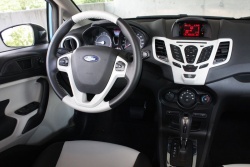Some owners have reported issues with the automatic dual-clutch transmission relating to hesitation and ‘clumsy’ operation, too. Strange vibrations or rattling sensations may be signs of trouble as well. Problems like these could be related to issues with the computer that controls the transmission, or even a bad electrical ground for said computer. This should be confirmed with a Ford mechanic if problems are noted.
Also note that the operation of a dual-clutch transmission means some very slight rolling-back on hills, or a slight delay between throttle application and forward motion, which is considered normal. Slippage, shuddering or hard shifting is not.
   Ford Fiesta, 2011–2013. Click image to enlarge |
Some reading on potential transmission problems here and here.
Confirm proper operation of the Ford Sync system, all steering wheel–mounted controls, and the Fiesta’s Bluetooth functionality, if equipped. Glitchy issues reported with the Sync system across various Ford models are numerous, and the Fiesta is no exception. Here’s some reading. Of course, as this sophisticated system is electronic in nature, many owners report that a reboot or software update can be the remedy. Be sure that’s the case. Link your phone via Bluetooth, place a call, have it read a text message, stream some audio and switch between input sources—ensuring the system operates with no issue.
  Ford Fiesta, 2011–2013. Click image to enlarge |
Ford even put this post on their website, detailing how to do a Sync ‘master reset’ to help solve problems.
Outside, inspect all four tires for signs of uneven wear across their treads. If one or more tires is worn more heavily at the inside or outside of its treads, the vehicle’s alignment is off – which could be evidence of a suspension-related issue. Vehicles with out-of-whack alignment can waste fuel, wear their tires out more quickly and burn excessive fuel. Ask your mechanic to have a closer look if you spot any signs of alignment trouble. Further, note that a Fiesta with a healthy suspension will absorb bumps without much fuss, and fairly quietly, while rebounding once and settling back to normal ride height. A Fiesta that makes popping or clunking noises, feels unstable or bounces excessively after going over a bump likely has some suspension repairs in its near future.
Shoppers should also confirm proper operation of the air conditioner and climate blower fan on all speed settings. Note any illuminated warning lights in the instrument cluster, possibly including “ABS” or ‘Check Engine” indicators. If any are apparent, be double-sure to have the cause checked by a Ford mechanic.
Other checks should include the power windows, power locks, remote key fobs, hatchback or trunk release and the front seats. Some owners have reported premature excessive wear or even indentations of said seats well before their time.
|
Related Articles: Manufacturer’s Website: |
The Verdict: Fiesta looks like a solid used-car buy, with most common issues being easy to identify, diagnose and repair should they be apparent. Expect sporty handling, solid quality and affordable flexibility – not to mention good fuel mileage. Pay extra attention to the onboard electronics and transmission to find a healthy used model.
An airbag recall.
Crash Test Results:
NHTSA: 4 / 5 Stars (2011 Fiesta Sedan)
IIHS: Top Safety Pick (2011 Fiesta Hatahback)











